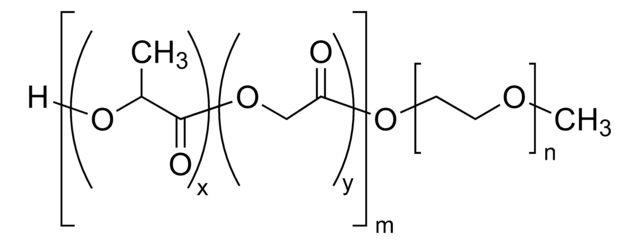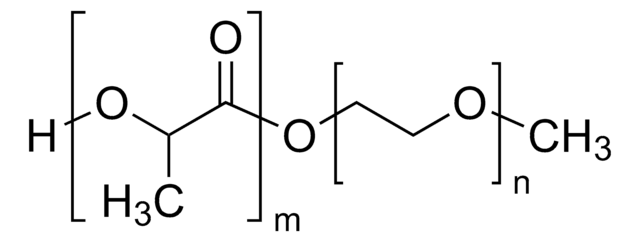764817
Poly(lactide-co-glycolide)-block-poly(ethylene glycol)-block-poly(lactide-co-glycolide)
average Mn (1100-1000-1100), lactide:glycolide 75:25
Synonym(s):
PLGA-PEG-PLGA
About This Item
Recommended Products
description
typical PEG PDI<1.1; overall PDI≤2.0 (THF, PS)
Quality Level
form
semisolid
feed ratio
lactide:glycolide 75:25
mol wt
PEG average Mn 1,000
PLGA average Mn 2,200
average Mn (1100-1000-1100)
degradation timeframe
2-3 weeks
transition temp
Tm 230-235 °C
PDI
<2.0
storage temp.
2-8°C
Looking for similar products? Visit Product Comparison Guide
Related Categories
General description
Application
Features and Benefits
Storage Class Code
11 - Combustible Solids
WGK
WGK 3
Flash Point(F)
Not applicable
Flash Point(C)
Not applicable
Choose from one of the most recent versions:
Already Own This Product?
Find documentation for the products that you have recently purchased in the Document Library.
Customers Also Viewed
Articles
Local delivery of bioactive molecules using an implantable device can decrease the amount of drug dose required as well as non-target site toxicities compared to oral or systemic drug administration.
Aliphatic polyesters such as polylactide, poly(lactide-co-glycolide) and polycaprolactone, as well as their copolymers, represent a diverse family of synthetic biodegradable polymers that have been widely explored for medical uses and are commercially available.
Humankind has utilized protein materials throughout its existence, starting with the use of materials such as wool and silk for warmth and protection from the elements and continuing with the use of recombinant DNA techniques to synthesize proteins with unique and useful properties.
Our team of scientists has experience in all areas of research including Life Science, Material Science, Chemical Synthesis, Chromatography, Analytical and many others.
Contact Technical Service







